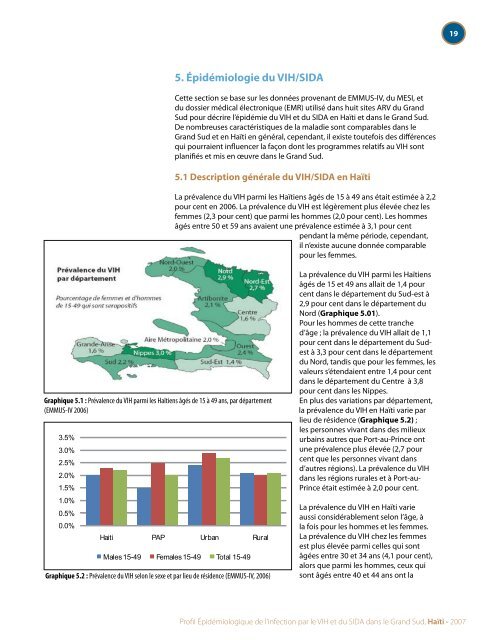Profil Épidémiologique de l'infection par le VIH et du SIDA ... - nastad
Profil Épidémiologique de l'infection par le VIH et du SIDA ... - nastad
Profil Épidémiologique de l'infection par le VIH et du SIDA ... - nastad
You also want an ePaper? Increase the reach of your titles
YUMPU automatically turns print PDFs into web optimized ePapers that Google loves.
5. Épidémiologie <strong>du</strong> <strong>VIH</strong>/<strong>SIDA</strong><br />
C<strong>et</strong>te section se base sur <strong>le</strong>s données provenant <strong>de</strong> EMMUS-IV, <strong>du</strong> MESI, <strong>et</strong><br />
<strong>du</strong> dossier médical é<strong>le</strong>ctronique (EMR) utilisé dans huit sites ARV <strong>du</strong> Grand<br />
Sud pour décrire l’épidémie <strong>du</strong> <strong>VIH</strong> <strong>et</strong> <strong>du</strong> <strong>SIDA</strong> en Haïti <strong>et</strong> dans <strong>le</strong> Grand Sud.<br />
De nombreuses caractéristiques <strong>de</strong> la maladie sont com<strong>par</strong>ab<strong>le</strong>s dans <strong>le</strong><br />
Grand Sud <strong>et</strong> en Haïti en général, cependant, il existe toutefois <strong>de</strong>s différences<br />
qui pourraient influencer la façon dont <strong>le</strong>s programmes relatifs au <strong>VIH</strong> sont<br />
planifiés <strong>et</strong> mis en œuvre dans <strong>le</strong> Grand Sud.<br />
5.1 Description généra<strong>le</strong> <strong>du</strong> <strong>VIH</strong>/<strong>SIDA</strong> en Haïti<br />
Graphique 5.1 : Préva<strong>le</strong>nce <strong>du</strong> <strong>VIH</strong> <strong>par</strong>mi <strong>le</strong>s Haïtiens âgés <strong>de</strong> 15 à 49 ans, <strong>par</strong> dé<strong>par</strong>tement<br />
Graph 5.2<br />
(EMMUS-IV 2006)<br />
3.5%<br />
3.0%<br />
2.5%<br />
2.0%<br />
1.5%<br />
1.0%<br />
0.5%<br />
0.0%<br />
Graphique 5.2 : Préva<strong>le</strong>nce <strong>du</strong> <strong>VIH</strong> selon <strong>le</strong> sexe <strong>et</strong> <strong>par</strong> lieu <strong>de</strong> rési<strong>de</strong>nce (EMMUS-IV, 2006)<br />
Graph 5.3<br />
5.0<br />
La préva<strong>le</strong>nce <strong>du</strong> <strong>VIH</strong> <strong>par</strong>mi <strong>le</strong>s Haïtiens âgés <strong>de</strong> 15 à 49 ans était estimée à 2,2<br />
pour cent en 2006. La préva<strong>le</strong>nce <strong>du</strong> <strong>VIH</strong> est légèrement plus é<strong>le</strong>vée chez <strong>le</strong>s<br />
femmes (2,3 pour cent) que <strong>par</strong>mi <strong>le</strong>s hommes (2,0 pour cent). Les hommes<br />
âgés entre 50 <strong>et</strong> 59 ans avaient une préva<strong>le</strong>nce estimée à 3,1 pour cent<br />
pendant la même pério<strong>de</strong>, cependant,<br />
il n’existe aucune donnée com<strong>par</strong>ab<strong>le</strong><br />
pour <strong>le</strong>s femmes.<br />
Haiti PAP Urban Rural<br />
Ma<strong>le</strong>s 15-49 Fema<strong>le</strong>s 15-49 Total 15-49<br />
La préva<strong>le</strong>nce <strong>du</strong> <strong>VIH</strong> <strong>par</strong>mi <strong>le</strong>s Haïtiens<br />
âgés <strong>de</strong> 15 <strong>et</strong> 49 ans allait <strong>de</strong> 1,4 pour<br />
cent dans <strong>le</strong> dé<strong>par</strong>tement <strong>du</strong> Sud-est à<br />
2,9 pour cent dans <strong>le</strong> dé<strong>par</strong>tement <strong>du</strong><br />
Nord (Graphique 5.01).<br />
Pour <strong>le</strong>s hommes <strong>de</strong> c<strong>et</strong>te tranche<br />
d’âge ; la préva<strong>le</strong>nce <strong>du</strong> <strong>VIH</strong> allait <strong>de</strong> 1,1<br />
pour cent dans <strong>le</strong> dé<strong>par</strong>tement <strong>du</strong> Su<strong>de</strong>st<br />
à 3,3 pour cent dans <strong>le</strong> dé<strong>par</strong>tement<br />
<strong>du</strong> Nord, tandis que pour <strong>le</strong>s femmes, <strong>le</strong>s<br />
va<strong>le</strong>urs s’étendaient entre 1,4 pour cent<br />
dans <strong>le</strong> dé<strong>par</strong>tement <strong>du</strong> Centre à 3,8<br />
pour cent dans <strong>le</strong>s Nippes.<br />
En plus <strong>de</strong>s variations <strong>par</strong> dé<strong>par</strong>tement,<br />
la préva<strong>le</strong>nce <strong>du</strong> <strong>VIH</strong> en Haïti varie <strong>par</strong><br />
lieu <strong>de</strong> rési<strong>de</strong>nce (Graphique 5.2) ;<br />
<strong>le</strong>s personnes vivant dans <strong>de</strong>s milieux<br />
urbains autres que Port-au-Prince ont<br />
une préva<strong>le</strong>nce plus é<strong>le</strong>vée (2,7 pour<br />
cent que <strong>le</strong>s personnes vivant dans<br />
d’autres régions). La préva<strong>le</strong>nce <strong>du</strong> <strong>VIH</strong><br />
dans <strong>le</strong>s régions rura<strong>le</strong>s <strong>et</strong> à Port-au-<br />
Prince était estimée à 2,0 pour cent.<br />
La préva<strong>le</strong>nce <strong>du</strong> <strong>VIH</strong> en Haïti varie<br />
aussi considérab<strong>le</strong>ment selon l’âge, à<br />
la fois pour <strong>le</strong>s hommes <strong>et</strong> <strong>le</strong>s femmes.<br />
La préva<strong>le</strong>nce <strong>du</strong> <strong>VIH</strong> chez <strong>le</strong>s femmes<br />
est plus é<strong>le</strong>vée <strong>par</strong>mi cel<strong>le</strong>s qui sont<br />
âgées entre 30 <strong>et</strong> 34 ans (4,1 pour cent),<br />
alors que <strong>par</strong>mi <strong>le</strong>s hommes, ceux qui<br />
sont âgés entre 40 <strong>et</strong> 44 ans ont la<br />
<strong>Profil</strong> <strong>Épidémiologique</strong> <strong>de</strong> l’infection <strong>par</strong> <strong>le</strong> <strong>VIH</strong> <strong>et</strong> <strong>du</strong> <strong>SIDA</strong> dans <strong>le</strong> Grand Sud, Haïti - 2007<br />
19


